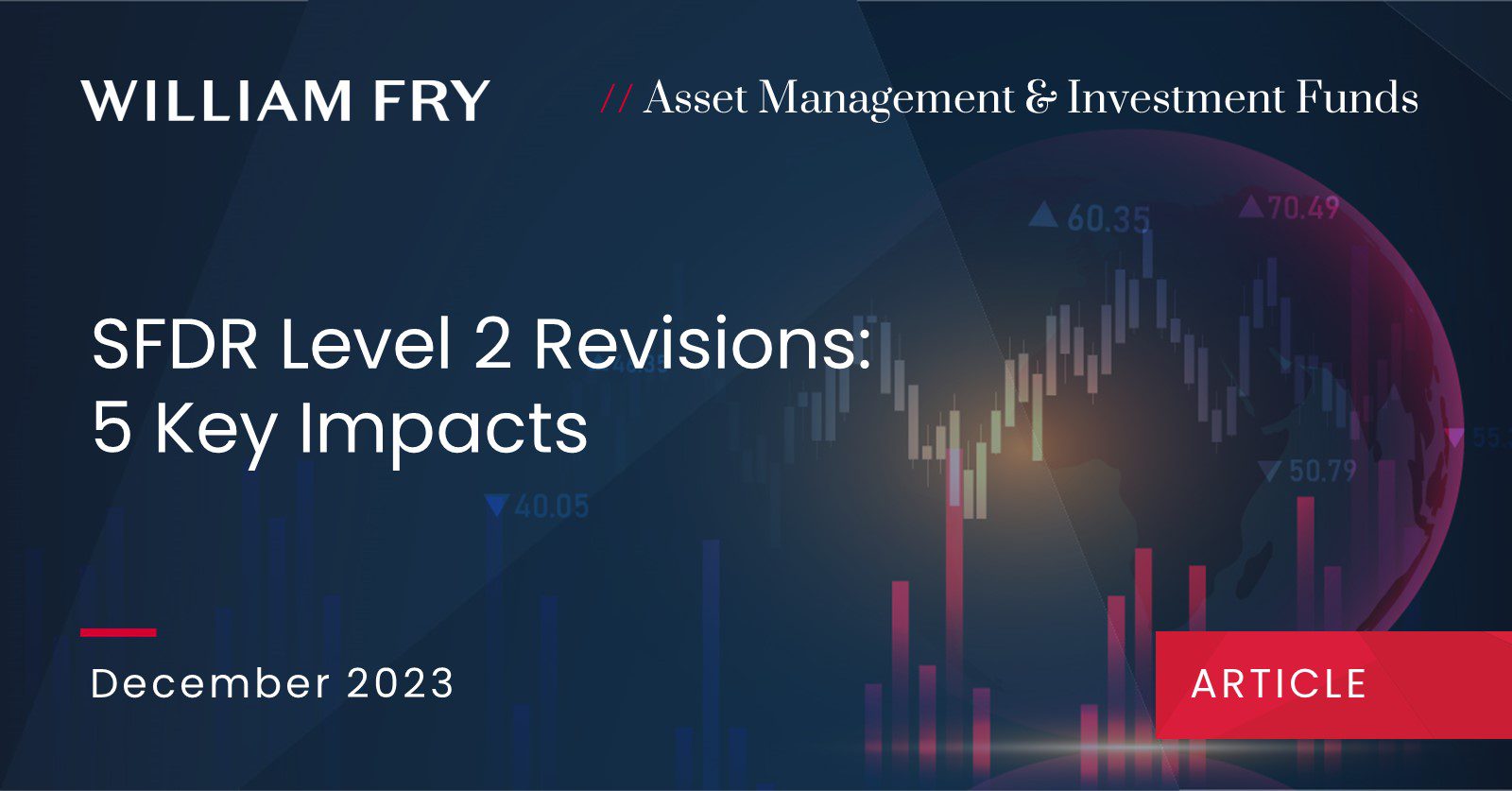On 4 December 2023, the European Supervisory Authorities (ESAs) published regulatory technical standards (RTS) amending the existing SFDR delegated measures (Level 2).
The RTS are now subject to a three-month scrutiny period before being adopted as Level 2 revisions by the Commission. Current estimations are for the revisions to be adopted with an application date in H1 2025.
The following are five key impacts of the RTS for fund management companies.
1. Amended Principal Adverse Impact Indicators, Disclosures and Calculations
Amended list of indicators
The mandatory principal adverse impact (PAI) indicators, set out in Table 1, Annex I of Level 2 and which are always considered to indicate an adverse social or environmental (E/S) impact of an investment, have been extended to include new indicators for investments in tobacco producers (PAI 15), companies with employees earning less than the adequate wage (PAI 16), and companies with significant activities in jurisdictions on the EU list of non-cooperative jurisdictions for tax purposes (PAI 13).
PAI 11 (lack of mechanisms to monitor UNGC/OECD MNE compliance) has been repurposed as an optional indicator.
As a result, there are 20, as opposed to the current 18, mandatory PAI indicators in the RTS.
In respect of the optional PAI indicators in Tables 2 and 3, Annex I of Level 2, the RTS include one new optional environmental PAI indicator (PAI 14 Radioactive waste ratio) for investee companies and 6 new optional social PAI indicators; PAI 4 Low coverage of collective bargaining agreements, PAI 10 Excessive use of non-guaranteed-hour employees in investee companies, PAI 11 Excessive use of temporary contract employees in investee companies, PAI 12 Excessive use of non-employee employees in investee companies, PAI 13 Insufficient employment of persons with disabilities within the workforce, PAI 21 Lack of remediation handling mechanism for consumers/end-users of the investee company). The previously mandatory PAI 11 (lack of mechanisms to monitor UNGC/OECD MNE compliance) has become an optional social PAI indicator (PAI 14) and the optional social PAI indicator ‘Lack of Due Diligence’ (PAI 10) has been deleted.
As a result there are 54 optional PAI indicators in the RTS, following the addition of 7 new optional PAI indicators and one repurposed mandatory PAI indicator.
The RTS also include revised descriptions and new and adjusted calculation methodologies for the PAI indicators.
In line with the Commission guidance on the Corporate Sustainability Reporting Directive (CSRD), the RTS provide that datapoints assessed as non-material by companies in scope of CSRD may be taken as not contributing to the adverse impact measured by the corresponding SFDR PAI indicator.
PAI disclosures
The ESAs currently refer to the disclosure of the share of PAIs based on data from investee companies and that based on estimated, as best practice in Level 3 guidance. The RTS codify this Level 3 guidance by requiring entity-level PAI statements to disclose, in the ‘Explanation’ column, (i) the proportion of the calculation that is based on data obtained from the investee company, sovereign/supranational or real estate asset, (ii) the proportion that was estimated or subject to reasonable assumptions and (iii) the proportion that was calculated by carrying out additional research or obtained from third party data providers/ external experts.
PAI calculations
Under the RTS, the calculation of PAIs has been clarified as requiring the inclusion of the PAIs of derivatives. The PAIs of derivatives must be calculated following the conversion of such positions using the methodologies set out in Annex II of AIFMD Level 2 and netting exposure using the AIFMD commitment method. Where the result of that calculation is below zero, the impact should not be reported but the short positions may be explained in the ‘Explanation’ column of the PAI statement.
In respect of PAIs of investee companies, information on the value chains of those companies must be reported where the investee companies report that information in accordance with applicable obligations under CSRD or where that information is readily available from investee companies not subject to CSRD.
2. Sustainable Investments: DNSH Threshold Disclosures and Prescribed Calculation Methodology
DNSH
Currently, Level 2 requires funds in scope of Article 8 or 9 SFDR to publish website disclosures including on how the sustainable investments satisfy the “do no significant harm” (DNSH) test by taking into account the mandatory and any relevant optional PAI indicators in Annex I of Level 2. The ESAs previously clarified in Level 3 guidance that they consider it best practice for such website disclosures to include appropriate values for the PAI indicators which, when respected, prove sustainable investments’ compliance with the DNSH principle. The RTS in effect codify this Level 3 guidance with a new obligation to make website disclosure of the thresholds or criteria applied to each PAI indicator used to assess the DNSH compliance of sustainable investments.
Calculation methodology
Level 2 does not currently set down a formula for calculating the proportion of sustainable investments of a fund in scope of Article 8 or 9. This is now addressed in the RTS which allow for the use of the following methodology where sustainable investments can be calculated at either activity or investment-level:
Market value of all sustainable investments of the financial product
Market value of all investments of the financial product
The inclusion of the above methodology in the RTS brings a level of clarity to the debate, ongoing since the introduction of SFDR, as to whether sustainable investments must be assessed and disclosed at the level of the investee entity/issuer or at the level of its activities. By providing for an activity-level calculation methodology, the RTS clarify that sustainable investments can be assessed at either investment or activity level. Furthermore, and following the safe-harbour introduced for investments in Taxonomy-aligned activities (which are deemed sustainable investments under SFDR), funds will be able to use the activity-based calculation for disclosing investments in Taxonomy-aligned activities as sustainable investments without further assessment of the non-Taxonomy-aligned portion of an investee entity’s activities.
3. New disclosure rules for funds with a GHG emission reduction target
The RTS include new disclosure obligations for those funds in scope of Article 8 or 9 which target a reduction in GHG emissions. Any fund which voluntarily adopts a GHG emission reduction target must disclose that target using the single metric of financed GHG emissions (gross emissions per million EUR invested). As a result, any adopted target which is not formulated in this way will require to be recalibrated in order to be disclosed in terms of reducing financed GHG emissions. Alternatively, the fund can disclose that it does not have a GHG emission reduction target. The RTS encourage the use of the Global GHG Accounting and Reporting Standard for the Financial Industry (PCAF Standard) for measuring financed GHG emissions and setting and monitoring progress towards their GHG emission reduction targets.
In mandating disclosure using a single metric, the ESAs seek to improve investor comparability of products with GHG emission reduction targets. The Level 2 disclosure templates have been revised in the RTS to require disclosure of the approach to reducing financed emissions. Such approach can include divestment from assets with particular GHG emission levels, investment in assets which are expected to reduce GHG emissions over time, engagement with investee entities to promote GHG emission reductions or another approach as adopted and disclosed for the fund. In addition, disclosure is required of baseline emissions and the final and any intermediate target for a reduction in financed GHG emissions, calculations of which must cover all investments in asset classes included in the PCAF Standard and may not include carbon credits and avoided emissions. The revised disclosure templates also require reporting on the degree of compatibility of a fund’s GHG emission reduction target with the objective of limiting global warming to 1.5 degrees. A separate disclosure option is provided in the RTS for funds with a GHG emission reduction target that invest in sovereign bonds.
4. Revised PCD and Periodic Disclosure Templates
In addition to the abovementioned amendments to the templates applicable for funds with GHG emission reduction targets, the templates have been revised to include a new dashboard of key information. Completion of the dashboard requires brief details (500-character limit) of the fund’s E/S characteristics/sustainable investment objective, the level of sustainable investments, the level of Taxonomy-aligned sustainable investments, whether the fund considers product-level PAIs and if the fund has a GHG emission reduction target. As a result of the inclusion of the dashboard, the current asset allocation chart has been removed from the templates.
Other changes have been made to the templates to simplify and improve the disclosures in response to consumer testing undertaken by the ESAs.
5. Machine readable disclosures
The RTS introduce a requirement for SFDR disclosures to be published in XHTML format and to mark up the information using the XBRL markup language, which markups must be embedded in the XHTML document using the Inline XBRL 1.1 specifications.
Next Steps
The RTS are now subject to scrutiny by the Commission for a period of three months (i.e. until 4 March 2024). If no objections are raised (as has previously been the case with ESA SFDR RTS), the RTS will be adopted as revised Level 2 measures by the Commission. While no indicative application date has been provided by the ESAs, current expectations are for the RTS to be adopted with an application date in H1 2025. As the RTS will trigger post-authorisation filings of all PCDs with the Central Bank, it is to be hoped that a streamlined regulatory filing process will be made available on terms similar to previous processes for template amendments.


